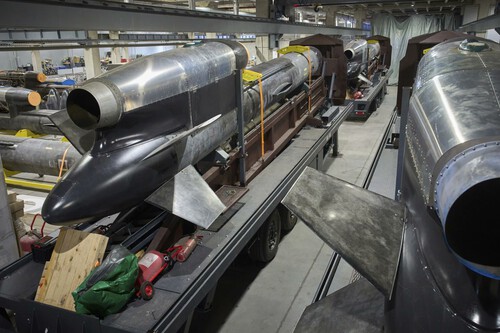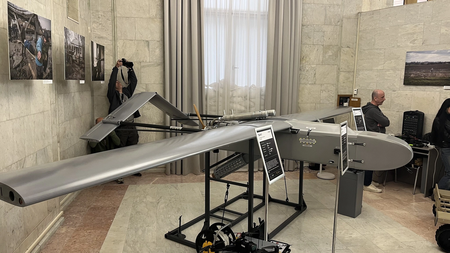Ucrânia encontrou tesouro contra a Rússia no lugar mais inesperado: locações secretas de filmagens
História de Fire Point resume fenômeno ucraniano: criatividade industrial convertida em poderio estratégico e transformada em ator militar fundamental
Que a guerra na Ucrânia se tornou o maior laboratório de drones do planeta em termos de combate é indiscutível. Tanto a Rússia quanto, principalmente, a Ucrânia, elevaram esses dispositivos a um patamar que configura uma indústria bélica sem precedentes, colocando as máquinas como o exército do futuro em qualquer conflito.
O que não era tão conhecido era a origem da maioria dos drones ucranianos.
Origem e metamorfose
O que começou há três anos como uma agência de locações e adereços em porões e garagens se transformou em uma indústria bélica em escala quase industrial: a Fire Point, cujo proprietário e executivos vêm do mundo do cinema e da construção de mobiliário urbano, passou da montagem de drones com peças comerciais à produção, segundo seus executivos, de centenas de munições propelidas e de longo alcance em pelo menos trinta locais secretos espalhados pela Ucrânia.
Mas há muito mais, pois a empresa cresceu tanto que se consolidou com contratos na casa dos bilhões de dólares num único ano. Uma transição que reflete a rápida profissionalização e comercialização de iniciativas nascidas do patriotismo e da urgência em fevereiro de 2022, quando oficinas clandestinas improvisadas se tornaram uma resposta eficaz (embora precária e fragmentada) a uma invasão em larga escala.
Produção, design e emprego
Os produtos da Fire Point, como o drone FP-1, são máquinas simples feitas de materiais (poliestireno, madeira compensada, plásticos e fibra de carbono de reciclagem), mas montadas com uma lógica de produção em massa: decolagem assistida por foguete, motor de dois tempos, alcance medido em centenas de quilômetros e ogivas com mais de cinquenta quilos em alguns modelos.
Seu catálogo também inclui o promissor míssil Flamingo, um dispositivo maior, com motor a jato e autonomia e carga teóricas que, se confirmadas em escala, poderiam reconfigurar a capacidade ucraniana de atingir alvos em profundidade. A filosofia industrial ucraniana aqui é clara: barato, descartável, massivo. A eficiência não exige reprocessamento ou longevidade, apenas que alguns exemplares ultrapassem as redes de defesa e cumpram sua missão específica.
Estratégia e efeitos militares
A proliferação dessas munições permitiu à Ucrânia sustentar uma campanha sistemática contra infraestruturas energéticas russas (refinarias e centros logísticos), buscando não apenas um efeito tático, mas também pressão estratégica e influência em eventuais negociações.
A multiplicidade de fabricantes nacionais e a adaptabilidade técnica obrigaram a Rússia a enfrentar uma erosão diária de sua aparente imunidade aérea, forçando-a a realocar recursos defensivos e a considerar a guerra de baixo custo como um vetor decisivo.
A ascensão meteórica da Fire Point não ocorreu sem controvérsias: denúncias públicas e auditorias apontam para licitações obscuras, ausência de negociações de preços obrigatórias, questionamentos sobre a qualidade técnica inicial e o possível envolvimento de atores ligados à mídia e ao meio empresarial próximos ao poder.
A Agência Nacional Anticorrupção investigou ligações com figuras associadas ao círculo presidencial e há apelos parlamentares para investigar preços, especificações e a destinação de lucros multimilionários. Apesar disso, a narrativa pública combina suspeita e exaltação: heróis nacionais e empresários estratégicos que reforçaram a capacidade defensiva, enquanto ativistas e analistas exigem mais controles e transparência nos contratos de guerra.
Industrialização e ecossistema
O fenômeno não é um caso isolado, mas o centro de uma revolução industrial: milhares de empresas, centenas focadas em drones de longo alcance e dezenas competindo por contratos, atraem fundos estrangeiros, parceiros e projetos de joint venture.
Órgãos estatais criam incentivos, enquanto fundos internacionais (como o recente veículo norueguês-ucraniano) mostram que o ecossistema está começando a se profissionalizar e a buscar legitimação comercial e tecnológica além da emergência. Para a defesa europeia e norte-americana, a Ucrânia agora oferece uma experiência única em missões não tripuladas e desenvolvimento rápido, o que desperta grande interesse tanto militar quanto industrial.
Sem dúvida, o equilíbrio levanta dilemas: a economia de guerra interna reduz a dependência de doações de aliados e aumenta a capacidade ofensiva, mas levanta questões sobre controle democrático, prestação de contas e o risco de que os lucrativos negócios de guerra se perpetuem além da necessidade estratégica.
Além disso, a proliferação de sistemas baratos e massivos exacerba a natureza assimétrica do conflito e apresenta riscos de escalada e responsabilidade difusa por objetivos seletivos e danos colaterais.
Perspectivas
Em suma, a história da Fire Point sintetiza o fenômeno ucraniano: a criatividade industrial (em muitos casos, não há outra escolha) convertida em um músculo estratégico, uma indústria que emergiu do voluntariado e se transformou em peça chave do aparato militar, mas também em foco de controvérsia por sua velocidade, suas margens e a opacidade típica de um país em guerra.
O desafio futuro é duplo: consolidar as capacidades tecnológicas e produtivas que continuam a ter um bom desempenho em combate e, ao mesmo tempo, inserir esse setor próspero em estruturas de governança e transparência que impeçam que a eficiência bélica evolua para economias de corrupção ou captura política.




